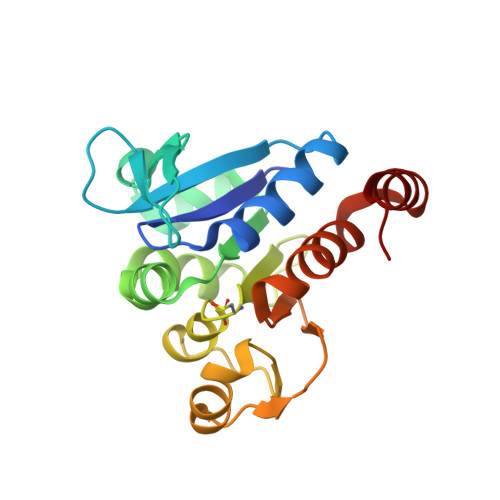Influence of peptide dipoles and hydrogen bonds on reactive cysteine pK(a) values in fission yeast DJ-1.
Madzelan, P., Labunska, T., Wilson, M.A.(2012) FEBS J 279: 4111-4120
- PubMed: 22971103
- DOI: https://doi.org/10.1111/febs.12004
- Primary Citation of Related Structures:
4GE0, 4GE3, 4QYT - PubMed Abstract:
Cysteine residues with depressed pK(a) values are critical for the functions of many proteins. Several types of interactions can stabilize cysteine thiolate anions, including hydrogen bonds between thiol(ate)s and nearby residues as well as electrostatic interactions involving charged residues or dipoles. Dipolar stabilization of thiolates by peptide groups has been suggested to play a particularly important role near the N-termini of α-helices. Using a combination of X-ray crystallography, site-directed mutagenesis and spectroscopic methods, we show that the reactive cysteine residue (Cys111) in Schizosaccharomyces pombe DJ-1 experiences a 0.6 unit depression of its thiol pK(a) as a consequence of a hydrogen bond donated by a threonine side chain (Thr114) to a nearby peptide carbonyl oxygen at the N-terminus of an α-helix. This extended hydrogen bonded interaction is consistent with a sum of dipoles model whereby the distal hydrogen bond polarizes and strengthens the direct hydrogen bond between the proximal amide hydrogen and the cysteine thiol(ate). Therefore, our results suggest that the local dipolar enhancement of hydrogen bonds can appreciably stabilize cysteine thiolate formation. However, the substitution of a valine residue with a proline at the i + 3 position has only a minor effect (0.3 units) on the pK(a) of Cys111. As proline has a reduced peptide dipole moment, this small effect suggests that a more extended helix macrodipolar effect does not play a major role in this system.
Organizational Affiliation:
Department of Biochemistry, University of Nebraska, Lincoln, USA.

















